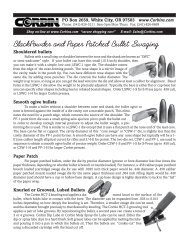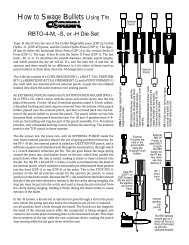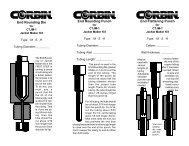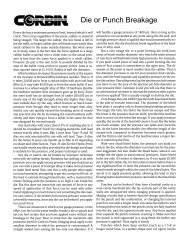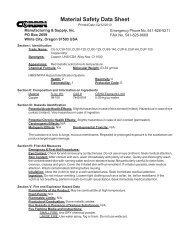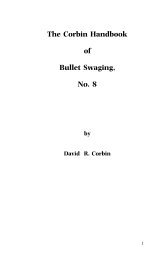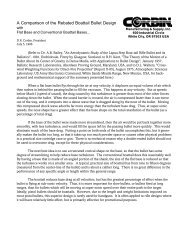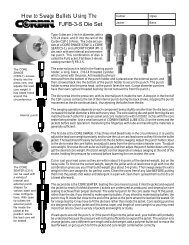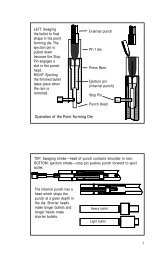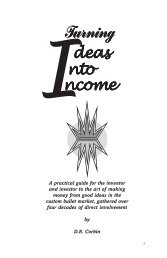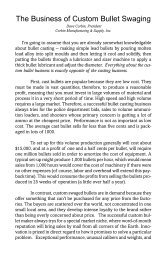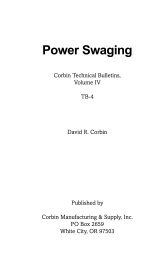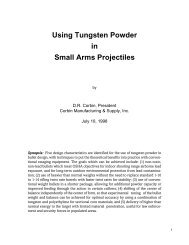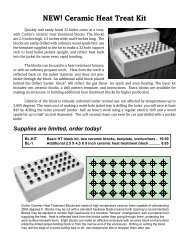HB-9 updated text (PDF) - Corbin Bullet Swaging
HB-9 updated text (PDF) - Corbin Bullet Swaging
HB-9 updated text (PDF) - Corbin Bullet Swaging
Create successful ePaper yourself
Turn your PDF publications into a flip-book with our unique Google optimized e-Paper software.
(A note about those Herter’s bullets: these were most likely reject<br />
bullets made because of a severe mismatch in a set of commercial swage<br />
dies, but Herter’s was innovative enough to turn someone else’s rejects<br />
into their “Model Perfect” offering of the season. Strange advantages were<br />
touted for this bullet: it was said that the air went in a sort of circle around<br />
that hourglass shape and somehow whipped around behind the bullet,<br />
whacked it in the rear and drove it faster! If this were true, Herter’s discovered<br />
a perpetual motion machine with a new twist. Imagine what<br />
would happen if you accidently gave one of those bullets a thump with<br />
your finger while it rested on the table: the air would start accelerating it<br />
faster and faster until it was zipping around the room at supersonic speed,<br />
blowing holes in all observed physics!)<br />
The pressure ring is not a design feature: it is a physical fact of life that<br />
gets in the way of having a nice parallel shank on the bullet and can<br />
expand the case neck as the bullet base passes through, leaving the bullet<br />
slightly loose. In a short-necked round like the .300 Savage, the pressure<br />
ring is a real problem, since the case holds part of the ring and part of the<br />
shank, and the bullet flops around as a result.<br />
Most of the time, the pressure ring doesn’t hurt anything but if there<br />
were a way to get rid of it without hurting accuracy in some other way, it<br />
should be done. The best way to minimize it is to match the core seater<br />
and point former dies very closely, more closely than you can do with a<br />
regular micrometer. You can also make the bullets slightly oversized and<br />
tapered, so the dies really eject easily, and then push the bullet through a<br />
ring die that irons the sides perfectly straight: now you’ve got a factory<br />
bullet! That’s the way it’s done. But that also tends toward a loose fit<br />
between jacket and core: the core pushes in and stays there, while the<br />
jacket springs back a tiny bit and loosens its grip on the core.<br />
If you bond the core (using <strong>Corbin</strong> Core Bond flux and melting the<br />
lead core into the jacket for a permanent adhesion), you can draw down<br />
the shank of the bullet without any springback effect. But all this is not<br />
necessary for target shooting and barely necessary for anything else so<br />
long as the ring is only slightly 0.001 inch or less) larger than the rest of<br />
the shank. If you have any problem with the bullet in a short necked case,<br />
then this is worth some consideration.<br />
The main thing is, don’t be suckered into thinking that you must have<br />
this mysterious feature in order to have a top-quality benchrest bullet. It’s<br />
just how they come out, no design required or intended, and rather than<br />
admit it, many bullet makers in the past have turned it into a “feature”.<br />
This is rather like the software bug that the technical support person claims<br />
is actually a feature: it’s supposed to work that way, didn’t you know?<br />
(Good thing software companies don’t design cars. Cars might have be-<br />
39



